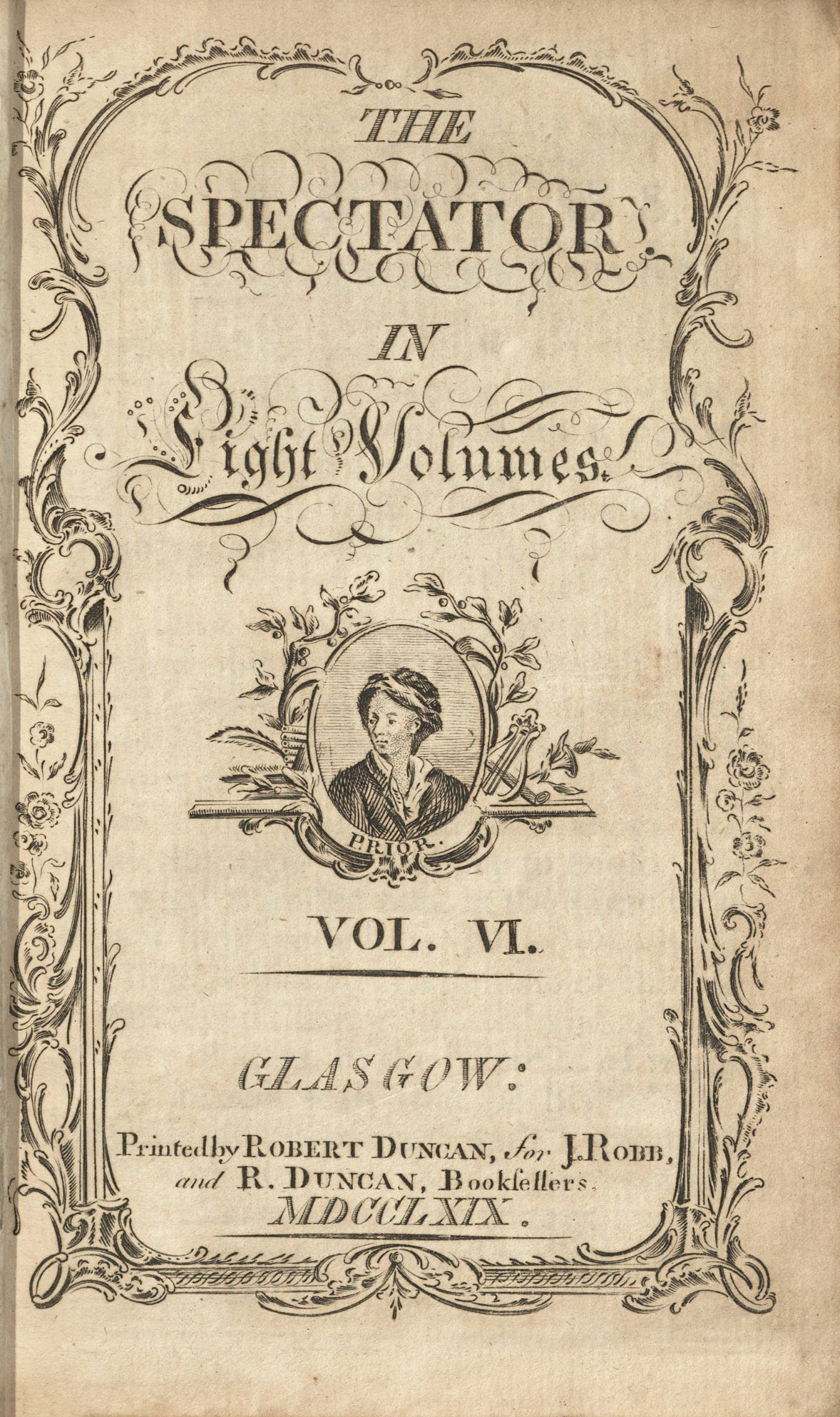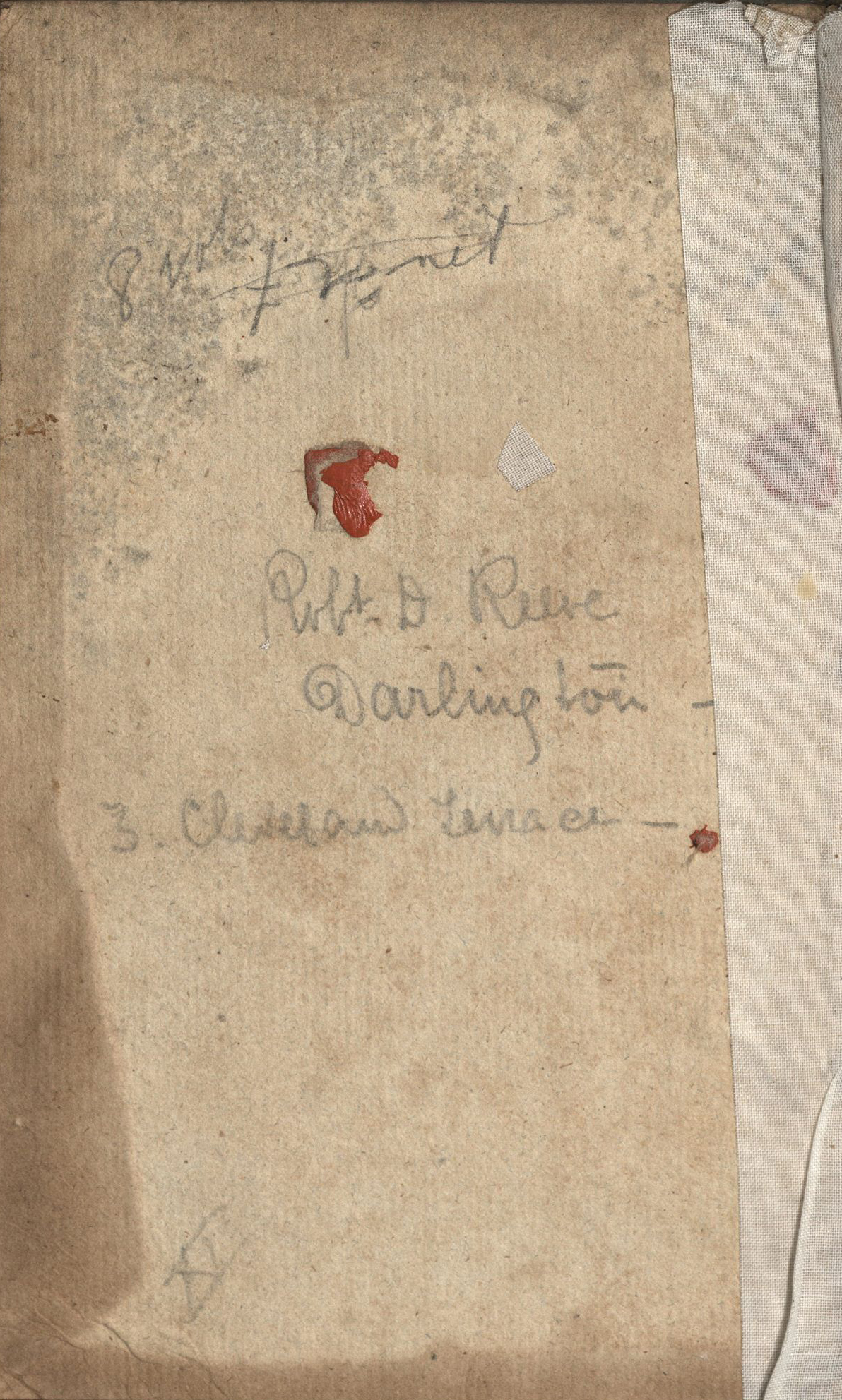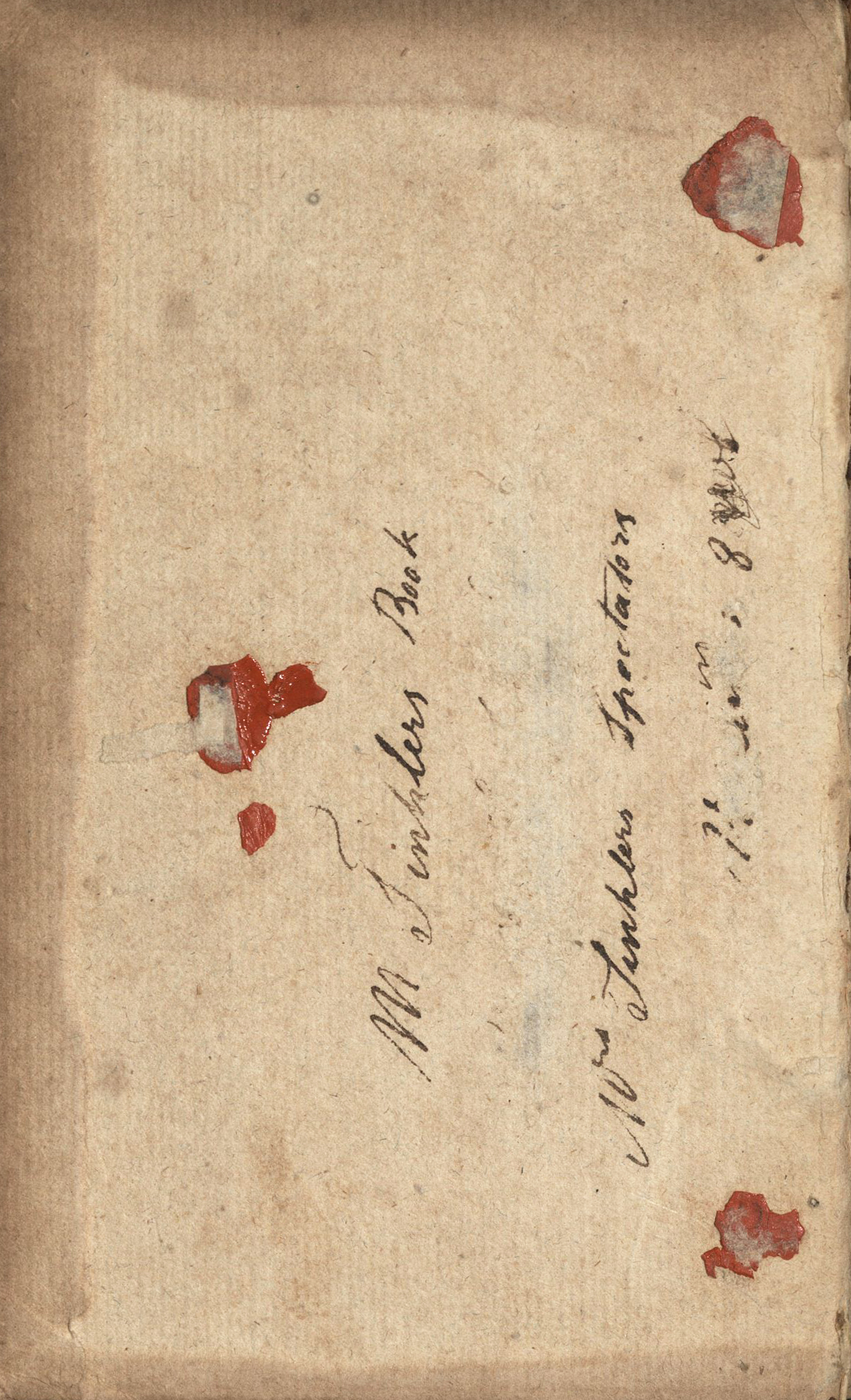The Spectator
by Joseph Addison and Sir Richard Steele, ed.
| The Spectator | |
|
Title page from The Spectator, volume six, George Wythe Collection, Wolf Law Library, College of William & Mary. | |
| Editor | Joseph Addison and Sir Richard Steele |
| Published | Glasgow: Printed by Robert Duncan for J. Robb and R. Duncan |
| Date | 1769 |
| Language | English |
| Volumes | 8 volume set |
| Desc. | 18 cm. |
| Location | Shelf M-1 |
Joseph Addison (1672-1719) was an English poet, dramatist, essayist, and statesman. Before distinguishing himself as a classical scholar at Oxford, he was classmates with Richard Steele at Charterhouse.[1] Addison first rose to national prominence after publishing The Campaign (1704), an epic poem depicting the Duke of Marlborough’s victory at Blenheim.[2] His literary success led to his selection as Undersecretary of State in 1705 and subsequent appointment as Secretary to the Lord Lieutenant of Ireland in 1709.[3] He also obtained a seat in Parliament from Malmesbury in 1708, which he held until his death.[4] Later, in 1717, Addison was chosen to serve as Secretary of State, a post he resigned a year later in 1718 due to poor health [5].
Although a prominent statesman, Addison is mostly remembered for his work as an essayist. In addition to cofounding The Spectator with Richard Steele in March of 1711, he also contributed to Steel’s publications, Tatler and the Guardian.[6][7] He wrote in a simple, orderly, and precise manner in an effort to engage his readers and inspire reasonable thinking and debate.[8] He achieved great success and fame during his lifetime and his publications are credited with raising the level of technical precision for English essayists.[9] Despite the success and fame that he achieved during his lifetime, from 1714 to his death in 1719, Addison quarreled with Steele and was plagued by poor health and a unhappy marriage [10].
Born in Dublin, Richard Steele (1672-1729) was an English playwright and essayist. After completing his studies alongside Joseph Addison at Charterhouse and later at Oxford, Steele began a career in the army in 1694 and obtained the rank of captain by 1701.[11] After serving in the army and low level government positions, he founded his renowned periodical, Tatler, in 1709.[12] He also cofounded The Spectator with Addison in 1711 and founded the Guardian in 1713.[13] Although Steele differed from Addison in temperament, their shared political beliefs and goals allowed them to form one of the greatest literary partnerships in the English language. He lacked Addison’s technical prowess but wrote with a style that was charming, imaginative, and witty.[14]
Steele entered Parliament in 1713 as a member of the Whig party.[15] Only a year after taking his seat, Steele was expelled from Parliament by his political rivals but returned in 1715 as a Hanoverian and was soon after knighted.[16] After a political dispute in 1719 with Addison relating to the Peerage Bill, Steele attempted to reconcile the friendship but Addison died the same year.[17] Forced to retire to Wales in 1724 due to increasing debt, Steele died in 1729 in relative obscurity.[18]
The Spectator made its first appearance on March 1, 1711 in London in an anonymous publication by Addison. The first issue introduced the series and its protagonist, Mr. Spectator. The second issue was written by Steele and detailed the members of a gentlemanly ‘club’ who were to be the associates of Mr. Spectator and the subjects of his observations. The public originally viewed the Spectator as a successor to Steele’s Tatler but Addison went to great lengths to dissociate the new journal from its predecessor, especially in regards to its politics.[19] Rather than focusing on defaming public or private individuals or engaging in any kind of personal attacks, the Spectator was to have a more scholarly approach to politics and a variety of other topics. He made clear his purpose for the Spectator when he wrote, “It was said of Socrates, that he brought Philosophy down from Heaven, to inhabit among Men; and I shall be ambitious to have it said of me, that I have brought Philosophy out of the Closets and Libraries, Schools and Colleges, to dwell in Clubs and Assemblies, at Tea-Tables and in Coffee-Houses".[20] Rather than a small, elite viewership, Addison and Steele were committed to writing in an accessible manner in order to attract a mass audience.
Many contemporary scholars, including Scott Paul Gordon, view the Spectator as an early influence for shaping the social norms and principles of politeness that guided the growing middle class in England. Gordon contends that Mr. Spectator encouraged readers to critically examine themselves in light of others and to alter one’s public actions and social interactions to fit an ideal public behavior, but in such a way that forwarded self-interest.[21] In the publications, an individual’s public behavior was portrayed as strategically adjusted to fit any given audience.[22] Therefore emphasis was placed less on personal authenticity and more on increasing one’s reputation and social standing.
Among the famous readers of the Spectator included the Reverend Cotton Mather, Joseph Collett, Dudley Ryder, and Voltaire, who read the publications to improve his English.[23]. Yet the journal's most ardent reader in the American colonies was undoubtedly the young Benjamin Franklin. Rather than simply reading the essays, Franklin rewrote them to improve both his writing style and manner of thinking. In Franklin's Autobiography, he wrote about his discovery of the Spectator during his period as an apprentice printer in Boston:
'About this time I met with an odd volume of the Spectator. It was the third. I had never before seen any of them. I bought it, read it over and over, and was much delighted with it. I thought the writing excellent, and wished, if possible to imitate it. With that view I took some of the papers, and, making short hints of the sentiment in each sentence, laid them by a few days, and then, without looking at the book, tried to complete the papers again by expressing each hinted sentiment at length, and as fully as it had been expressed before, in any suitable words that should come to hand. Then I compared my spectator with the original, discovered some of my faults, and corrected them...By comparing my work afterwards with the original, I discovered many faults and amended them; but I sometimes had the pleasure of fancying that in certain particulars of small import I had been lucky enough to improve the method of the language, and this encouraged me to to think I might possibly in time come to be a tolerable English writer, of which I was extremely ambitious' (13-14)(McCrea, 252).
The Spectator ran for two years until its 555th issue on December 6, 1712.[24] It achieved an unmatched level of circulation for its time with 3,000 issues printed six days a week. More impressive still, it has been estimated that there were five or six readers for every copy printed. Addison and Steele wrote an equal amount of essays for the Spectator during their partnership: 251 each.[25]
Evidence for Inclusion in Wythe's Library
Listed in the Jefferson Inventory of Wythe's Library as Spectator. An odd vol. and given by Thomas Jefferson to his son-in-law, Thomas Mann Randolph. May later appear on Randolph's 1832 estate inventory in the "Lot of odd Vols: $2.00." We do not have enough information to conclusively identify which edition Wythe owned. George Wythe's Library[26] on LibraryThing indicates "Odd volume. Precise edition unknown." The Brown Bibliography[27] suggests "the duodecimo edition and not the more valued and important folio edition." The Wolf Law Library purchased a copy of the duodecimo edition.
Description of the Wolf Law Library's copy
Bound in full calf. Spines feature raised bands and gilt decorative motifs. Title in gilt on red morocco labels; volume numbers in gilt on black labels. Purchased with the George Wythe Boswell-Caracci Room Acquisition Fund.
Images of the library's copy of this book are available on Flickr. View the record for this book in William & Mary's online catalog.
See also
- Jefferson Inventory
- The Miscellaneous Works, in Verse and Prose, of the Right Honorable Joseph Addison, Esq.
- Wythe's Library
References
- ↑ "Addison, Joseph". 2015. In The Columbia Encyclopedia. New York: Columbia University Press.
- ↑ "Addison, Joseph". 2011. In Chambers Biographical Dictionary. London: Chambers Harrap.
- ↑ The Columbia Encyclopedia, Addison, Joseph.
- ↑ Chambers Biographical Dictionary,Addison, Joseph.
- ↑ (Ibid)
- ↑ The Columbia Encyclopedia, Addison, Joseph.
- ↑ Chambers Biographical Dictionary, Addison, Joseph
- ↑ The Columbia Encyclopedia, Addison, Joseph.
- ↑ Ibid.
- ↑ Ibid.
- ↑ Steele, Sir Richard. (2015). In The Columbia Encyclopedia. New York, NY: Columbia University Press.
- ↑ "Steele, Sir Richard". 2011. In Chambers Biographical Dictionary. London: Chambers Harrap.
- ↑ The Columbia Encyclopedia, Steele, Sir Richard.
- ↑ Ibid.
- ↑ Ibid.
- ↑ Chambers Biographical Dictionary, Steele, Sir Richard.
- ↑ The Columbia Encyclopedia, Steele, Sir Richard.
- ↑ Ibid.
- ↑ Smithers, Peter. The Life of Joseph Addison. Oxford: Clarendon Press, 1968, 207-208.
- ↑ Spectator 10, 1:44
- ↑ Gordon, Scott Paul. The Power of the Passive Self in English Literature, 1640-1770. Cambridge, UK: Cambridge University Press, 2002, 87. eBook Collection (EBSCOhost), EBSCOhost (accessed May 27, 2015).
- ↑ Ibid., 88.
- ↑ McCrea, Brian. “The Virtue of Repetition.” In The Spectator: Emerging Discourses, edited by Donald J. Newman, 248. Delaware: The University of Delaware Press, 2010.
- ↑ Otton, Robert M. Joseph Addison. Boston: Twayne Publishers, 1982, 83-84.
- ↑ Ibid.
- ↑ LibraryThing, s.v. "Member: George Wythe," accessed on June 8, 2023.
- ↑ Bennie Brown, "The Library of George Wythe of Williamsburg and Richmond," (unpublished manuscript, May, 2012) Microsoft Word file. Earlier edition available at: https://digitalarchive.wm.edu/handle/10288/13433.



